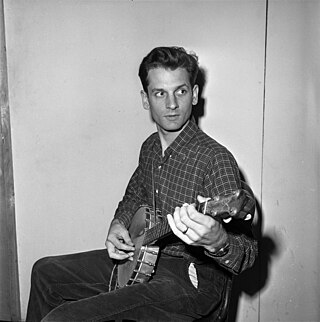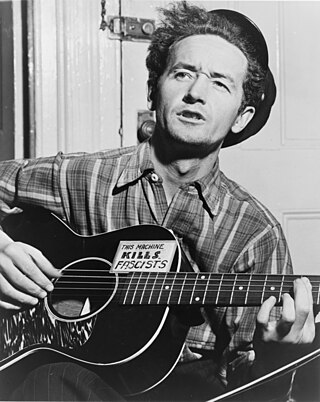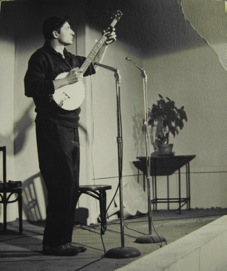Related Research Articles

Peter Seeger was an American folk singer and social activist. He was a fixture on nationwide radio in the 1940s, and had a string of hit records during the early 1950s as a member of The Weavers, notably their recording of Lead Belly's "Goodnight, Irene," which topped the charts for 14 weeks in 1950. Members of the Weavers were blacklisted during the McCarthy Era. In the 1960s, Seeger re-emerged on the public scene as a prominent singer of protest music in support of international disarmament, civil rights, counterculture, workers' rights, and environmental causes.
The U.S. state of North Carolina is known particularly for its history of old-time music. Many recordings were made in the early 20th century by folk song collector Bascom Lamar Lunsford. Influential North Carolina country musicians like the North Carolina Ramblers and Al Hopkins helped solidify the sound of country music in the late 1920s, while influential bluegrass musicians such as Earl Scruggs and Doc Watson came from North Carolina. Arthur Smith had the first nationally syndicated television program which featured country music. He composed "Guitar Boogie", the all-time best selling guitar instrumental, and "Dueling Banjos", the all-time best selling banjo composition. Country artist Eric Church from the Hickory area, has had multiple No. 1 albums on the Billboard 200, including Chief in 2011. Both North and South Carolina are a hotbed for traditional country blues, especially the style known as the Piedmont blues. Elizabeth Cotten, from Chapel Hill, was active in the American folk music revival.

Old-time music is a genre of North American folk music. It developed along with various North American folk dances, such as square dancing, contra dance, clogging, and buck dancing. It is played on acoustic instruments, generally centering on a combination of fiddle and plucked string instruments, most often the banjo, guitar, and mandolin. Together, they form an ensemble called the string band, which along with the simple banjo-fiddle duet have historically been the most common configurations to play old-time music. The genre is considered a precursor to modern country music.

Moran Lee "Dock" Boggs was an American old-time singer, songwriter, and banjo player. His style of banjo playing, as well as his singing, is considered a unique combination of Appalachian folk music and African-American blues. Contemporary folk musicians and performers consider him a seminal figure, at least in part because of the appearance of two of his recordings from the 1920s, "Sugar Baby" and "Country Blues", on Harry Smith's 1952 collection Anthology of American Folk Music. Boggs was first recorded in 1927 and again in 1929, although he worked primarily as a coal miner for most of his life.

Mike Seeger was an American folk musician and folklorist. He was a distinctive singer and an accomplished musician who mainly played autoharp, banjo, fiddle, dulcimer, guitar, harmonica, mandolin, dobro, jaw harp, and pan pipes. Seeger, a half-brother of Pete Seeger, produced more than 30 documentary recordings, and performed in more than 40 other recordings. He desired to make known the caretakers of culture that inspired and taught him. He was posthumously inducted into the International Bluegrass Music Hall of Fame in 2018.
Clogging, buck dancing, or flatfoot dancing is a type of folk dance practiced in the United States, in which the dancer's footwear is used percussively by striking the heel, the toe, or both against a floor or each other to create audible rhythms, usually to the downbeat with the heel keeping the rhythm. Clogging can be found at various Old-Time and Bluegrass Music festivals.

Bascom Lamar Lunsford was a folklorist, performer of traditional Appalachian music, and lawyer from western North Carolina. He was often known by the nickname "Minstrel of the Appalachians."

Appalachian music is the music of the region of Appalachia in the Eastern United States. Traditional Appalachian music is derived from various influences, including the ballads, hymns and fiddle music of the British Isles, and to a lesser extent the music of Continental Europe.

Elizabeth "Libba" Cotten was an influential American folk and blues musician. She was a self-taught left-handed guitarist who played a guitar strung for a right-handed player, but played it upside down. This position meant that she would play the bass lines with her fingers and the melody with her thumb. Her signature alternating bass style has become known as "Cotten picking". NPR stated "her influence has reverberated through the generations, permeating every genre of music."

The American folk music revival began during the 1940s and peaked in popularity in the mid-1960s. Its roots went earlier, and performers like Josh White, Burl Ives, Woody Guthrie, Lead Belly, Big Bill Broonzy, Richard Dyer-Bennet, Oscar Brand, Jean Ritchie, John Jacob Niles, Susan Reed, Paul Robeson, Bessie Smith, Ma Rainey and Cisco Houston had enjoyed a limited general popularity in the 1930s and 1940s. The revival brought forward styles of American folk music that had in earlier times contributed to the development of country and western, blues, jazz, and rock and roll music.

Fleming Brown, born in Marshall, Missouri, United States, was an American banjo player and one of the early teachers at Chicago's Old Town School of Folk Music. As an artist, Brown specialized in traditional songs of the Southern Appalachians. He was influenced by old-time banjo players such as Uncle Dave Macon and Dock Boggs. Brown supported himself as a graphic artist and as such never performed widely outside of Chicago.
"I Wish I Was a Mole in the Ground" is a traditional American folk song. It was most famously recorded by Bascom Lamar Lunsford in 1928 for Brunswick Records in Ashland, Kentucky. Harry Smith included "I Wish I Was a Mole in the Ground" on his Anthology of American Folk Music released by Folkways Records in 1952. The notes for Smith's Anthology state that Lunsford learned this song from Fred Moody, a North Carolina neighbor, in 1901.

"Good Old Mountain Dew", sometimes called simply "Mountain Dew" or "Real Old Mountain Dew", is an Appalachian folk song composed by Bascom Lamar Lunsford and Scotty Wiseman. There are two versions of the lyrics, a 1928 version written by Lunsford and a 1935 adaptation by Wiseman. Both versions of the song are about moonshine. The 1935 version has been widely covered and has entered into the folk tradition becoming a standard.

"Aunt" Samantha Bumgarner was an American early country and folk music performer and singer from Dillsboro, North Carolina. She won much praise for her work with the fiddle and banjo. In 1924, accompanied by guitarist Eva Davis, she traveled to New York City and recorded about a dozen songs for Columbia Records. The recordings are also notable for being the first use of a 5-string banjo on a recording. She was a yearly staple at Bascom Lamar Lunsford's Mountain Dance and Folk Festival from 1928 until shortly before her death.
"Cumberland Gap" is an Appalachian folk song that likely dates to the latter half of the 19th century and was first recorded in 1924. The song is typically played on banjo or fiddle, and well-known versions of the song include instrumental versions as well as versions with lyrics. A version of the song appeared in the 1934 book, American Ballads and Folk Songs, by folk song collector John Lomax. Woody Guthrie recorded a version of the song at his Folkways sessions in the mid-1940s, and the song saw a resurgence in popularity with the rise of bluegrass and the American folk music revival in the 1950s. In 1957, the British musician Lonnie Donegan had a No. 1 UK hit with a skiffle version of "Cumberland Gap".
Roger Sprung was an American banjo player and teacher best known for introducing authentic bluegrass banjo picking styles to the folk music community in the north and for the eclectic manner in which he adapted bluegrass banjo techniques to music of other genres. His 1963 album Progressive Bluegrass may have been the first use of that title, later applied to a subgenre of bluegrass music by him and others. In 2020, he was inducted into the American Banjo Museum Hall of Fame under the Instruction & Education category.
Lamar Edwin Stringfield was a classical composer, flutist, symphony conductor, and anthologist of American folk music.
Martin Douglas Wallin was a ballad singer and fiddler born in Madison County, North Carolina, and a recipient of a 1989 North Carolina Heritage Award.
Carroll Best was an American bluegrass banjo player and music educator. He was briefly a member of The Morris Brothers in the mid 1950s. He was the winner of several regional banjo contests before being awarded the widely recognized Bascom Lamar Lunsford Award in 1990. He is credited for developing an influential melodic three-finger banjo style, which he taught as a member of the faculty at the Tennessee Banjo Institute. This style influenced the work of musicians Tony Trischka and Bela Fleck. His work was featured on radio broadcasts for NPR and The Grand Ole Opry, and on the television program Hee Haw. He released two albums while he was alive, and a third album of his work was released posthumously in 2001. He is listed as a historic artist by the Blue Ridge National Heritage Area, and was given the North Carolina Heritage Award in 1994.
Dave Sear is an American folk singer and banjo player. He performed and recorded with musicians that included Mary Travers, Jean Ritchie, and Oscar Brand. He was also part of the American Folk Trio with Sonja Savig and Lee Kahn. Sear also had a career as a radio host and producer for the national syndicated radio program Folk Music Almanac which aired on WNYC in New York City for over 40 years from 1959 to 1996.
References
- 1 2 "Shindig on the Green: 52 years of music 'round about sundown 🎻 - AVLToday". 25 July 2018.
- ↑ "Mountain Dance and Folk Festival turns 90".
- ↑ "Mountain Dance and Folk Festival - Digital Heritage". 5 March 2012.
- ↑ "North Carolina: Looking for music? Here's where to start".
- 1 2 Jones, Loyal (1984). Minstrel of the Appalachians: The Story of Bascom Lamar Lunsford .
- 1 2 Fussell, Fred; Kruger, Steve (2018). Blue Ridge Music Trails of North Carolina: A Guide to Music Sites, Artists, and Traditions of the Mountains and Foothills.
- ↑ "Feasts of Unnaming". xroads.virginia.edu. Archived from the original on July 28, 1997.
- ↑ Schubert, Leda (2017). Listen: How Pete Seeger Got America Singing.
- ↑ Dunaway, How Can I Keep From Singing, pp. 48–49.